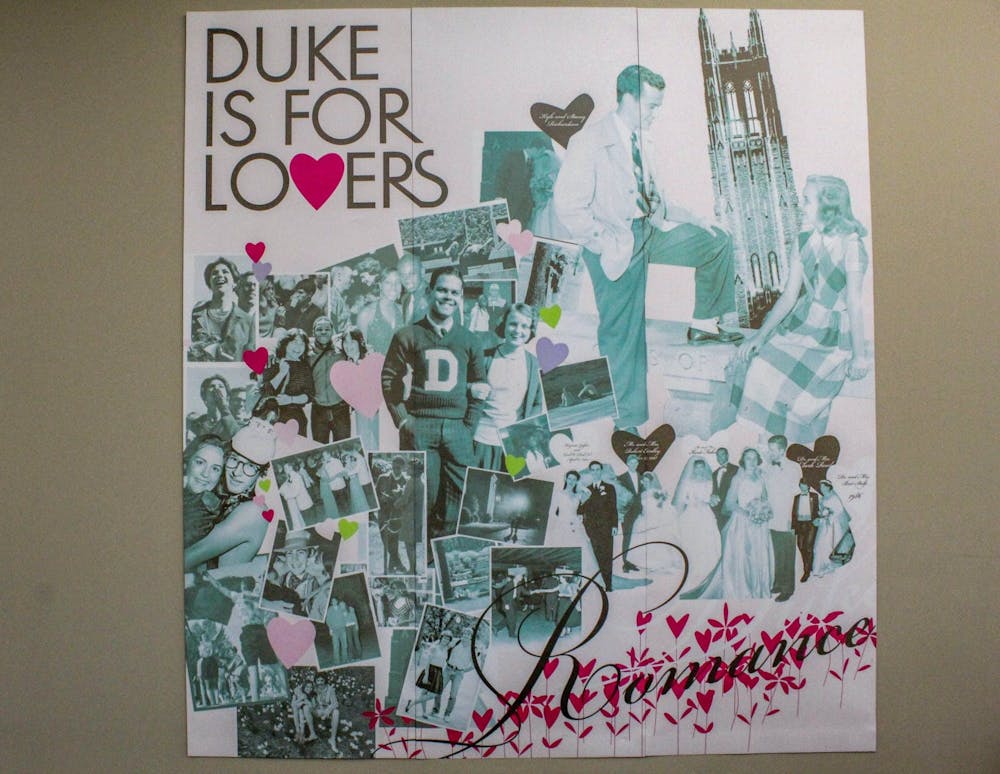Far past the first floor Perkins library desk and hidden behind bookshelves and tables, a mural is plastered against the wall, with its colors faded by years of sunlight exposure. The top of the installation is titled: “Duke is for Lovers.” Below the text are photos of Duke couples throughout many years getting married.
Mollie Eardley, Trinity ‘93 and Fuqua ‘98, and Robert Eardley, Fuqua ‘97, are pictured on the right-hand side in front of a heart motif with the date of their wedding at the Duke Chapel. The two first met during their orientation at the Fuqua School of Business but didn’t get a chance to get to know each other until Robert went up to Mollie during a Durham Bulls game later that week.
Soon they became friends, as they saw each other around campus, and were engaged by the following September.
“I knew she was the one,” Eardley said. “So it was kind of an easy choice. And here we are 24 years later — almost 25 this coming year — and it's still the right choice.”
Though the mural has been hanging up in Perkins since 2007, the Eardleys had no idea their names and faces had been put up on the mural. The “Duke is for Lovers” mural is one of four murals in the library that were made for the same event, a library party almost 16 years ago.
Library parties were created in the wake of the 2006 lacrosse case, when three Duke lacrosse players were falsely accused of rape. Rachel Walter, Trinity ‘07, and Hayley Hoffman Chung, Trinity ‘07, wanted to reframe student social life at the University to provide an alternative to fraternity events.
According to Walter, the lacrosse scandal started conversations on campus about shifting the culture away from “privileged white men dictating everything about how we socialize,” according to Walter. As a solution, Walter and Hoffman Chung started DukePlays to host annual library parties.
Until 2017, the parties were formal events hosted in the Bostock and Perkins Libraries and the von der Heyden Pavilion. They stopped due to concern about fire hazards due to high attendance, according to an email from Aaron Welborn, director of communications of Duke University Libraries.
DukePlays aimed to “create an opportunity for people to come together and party in a way that was not about taking shots and centered in these very male-oriented ways,” Walter said.
As the 2007 Old Duke concert approached, Walter and Hoffman Chung went around to different student organizations, fundraising $35,000 with 34 sponsors to host a party in the libraries. In addition to catering, drinks and dancing, Walter wanted to accompany the party with art installations representing University social life.
“I locked myself in Duke archives for like a week or something,” Walter said. “I sat there and went through all these old photos and the themes started to emerge.”
From these archival photos, Walter put together the four pieces: “Duke is for Lovers,” “Duke Athletics,” “Duke Arts” and “Duke Activism.” Each mural includes a collage of photos showcasing the history of the University from different angles.
As she looked at photos of Duke couples dating she thought of “this idea of guys and girls go to frat parties, go to Shooters, and that’s how you court in undergrad. And I saw these pictures ... and it just made me imagine a broadening of that idea.”
The activism mural has a host of images of students and faculty participating in social movements and protests on issues ranging from the Civil Rights Movement to the AIDS/HIV crisis.
“I thought the activism story was so powerful,” Walter said. “We do have this [activism] in our DNA, and I just felt like it was inspirational for students to see something like this.”
Another point of inspiration is showcased in the arts mural, where a photo depicts a message on the East Campus graffiti bridge. In the photo, dark writing on a white backsplash reads “DukePlay: work hard, play well.”
Walter and Hoffman Chung painted the mural to advertise their event, but they also found profound importance in that slogan. At that time, Walter said there was a notion of “effortless perfection” and women on campus were expected to work hard but not show hardship.
Walter said they were drawn to the slogan because it acknowledges the hard work that students put in, but it adds a bit more “class” to the “work hard, play hard” saying.
“Partying hard entails some not so great things for women and marginalized communities on campus,” Walter pointed out.
Walter hopes that the murals have “called attention to the University’s culture in a way that's not limited to these very traditional ideas about what it means to work hard, play hard.”
Get The Chronicle straight to your inbox
Sign up for our weekly newsletter. Cancel at any time.
The future of these fading murals is undecided, according to Welborn, but while they stand, they reflect parts of Duke’s history through art and stories.
The University hasn’t removed the murals yet because they were “affixed in such a way that removing them might damage the wall” Welborn wrote, adding that the murals contribute “a splash of color” to the “otherwise drab” Perkins walls.
As for the “Duke is for Lovers” mural — when Robert Eardley comes back to campus to take one of his children to a Duke basketball game, he hopes to be able to find the image of him and his wife, a little piece of Duke history nestled in the corner of Perkins.

Olivia Kim is a Trinity first-year and a staff reporter of The Chronicle's 118th volume.

